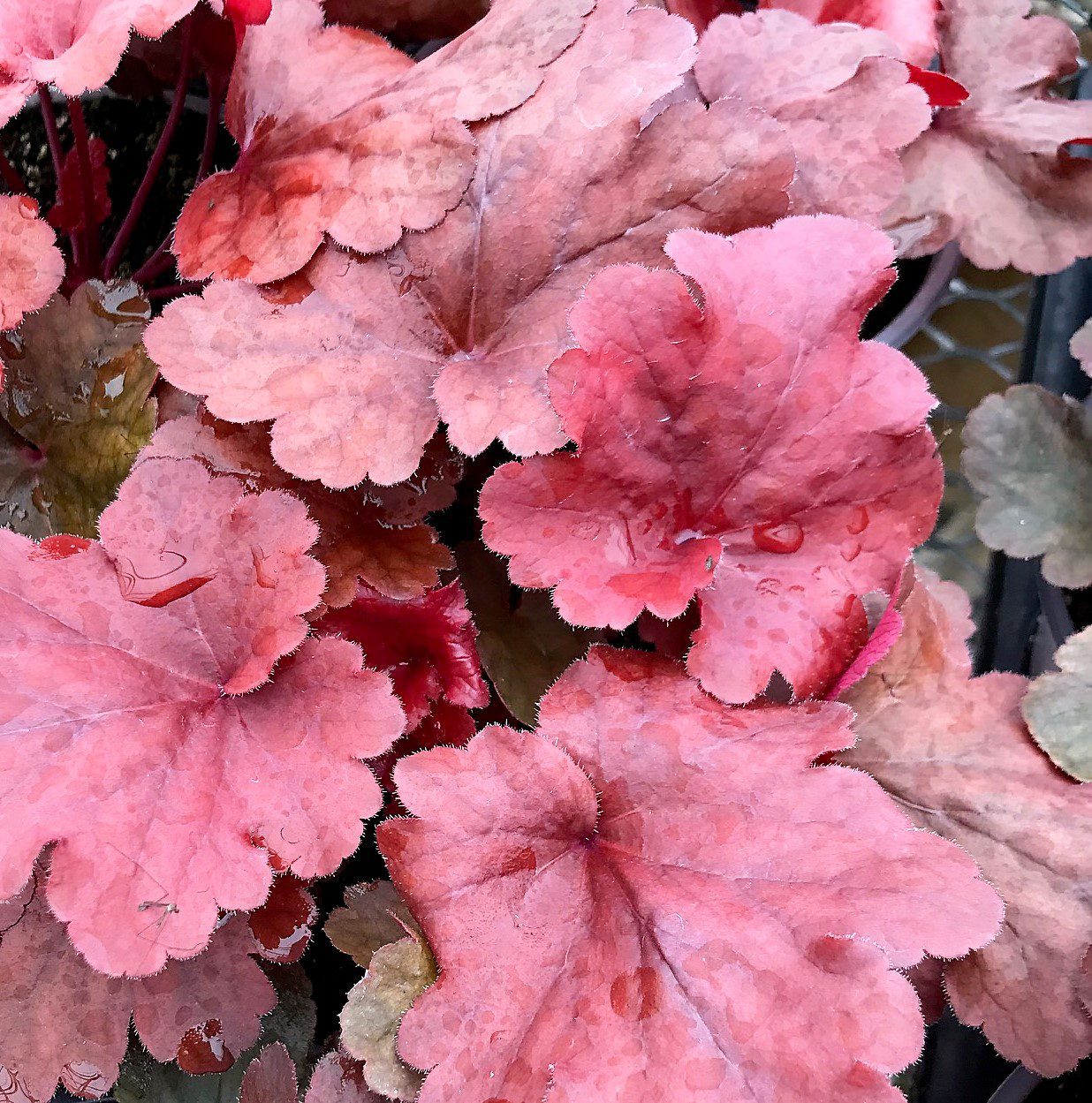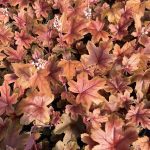Heuchera, Fire Alarm
Price range: $7.99 through $14.99
Plant, Zone 4+
Discount per quantity
| Quantity | 3 - 8 | 9 - 14 | 15+ |
|---|---|---|---|
| Price | Price range: $7.75 through $14.54 | Price range: $7.51 through $14.09 | Price range: $7.19 through $13.49 |
| % Discount | 3% | 6% | 10% |
Description
Heuchera ‘Fire Alarm’: A Blazing Jewel for Every Garden
A Warm Welcome to Color
You and I share a love for bold color. No plant answers that call quite like Heuchera ‘Fire Alarm’. Its leaves glow red, orange, and scarlet, just like sparks from a campfire. In other words, you gain a living ember that burns bright from the first thaw through winter’s chill. This deep-dive guide gives us everything needed to grow, enjoy, and share this standout coral bell—step by easy step.
Meeting the Spark: Form, Foliage, and Flair
Leaf Magic All Year
- Spring:* New leaves unfurl in cherry red. They shine against the soft light of early mornings.
- Summer:* Heat deepens the tone to true fire-engine red, yet the surface stays satin-smooth.
- Autumn:* Cooler nights layer burgundy over the flames, adding depth.
- Winter:* Evergreen mounds hold maroon shades, letting gardens glow even in snow.
Compact Yet Dramatic
Mature plants stand about ten inches tall, with a spread near sixteen inches. Rounded leaves overlap to form tight cushions. Slender stems rise above in early summer, carrying dainty white flowers that dance in the breeze.
A Hybrid With Purpose
Breeders crossed hardy native species to create strength, color, and disease resistance. After more than years of careful selection, ‘Fire Alarm’ was born, giving gardeners a reliable splash of heat in borders, pots, and shady beds.
Preparing the Stage: Soil, Light, and Location
Soil Preferences
- Loose, rich loam helps roots breathe.
- pH around 6.2 to 6.8 keeps nutrients available.
- Good drainage prevents crown rot, the main enemy of coral bells.
Amend heavy clay with compost and pine fines. Sandy soil benefits from added organic matter to hold moisture.
Light Levels
Morning sun plus afternoon shade works best in hot regions. Farther north, plants handle half a day of sunshine. Deep shade softens color; bright light intensifies it. Instead of guessing, use dappled light beneath trees for a sure win.
Spacing and Airflow
Set plants twelve to eighteen inches apart. Air movement cuts down on mildew and keeps leaves dry after rain.
Planting Day: Simple Steps for Success
- Dig a hole twice as wide as the pot and just as deep.
- Loosen roots gently.
- Place the crown level with surrounding soil.
- Backfill, firm lightly, and water well.
- Mulch two inches thick, leaving a small gap at the stem.
That method anchors the plant while letting crowns stay dry.
Everyday Care: Water, Food, and Mulch
Water Wisdom
Young plants need steady moisture. Once established, ‘Fire Alarm’ prefers soil that dries slightly between waterings. Drip lines work better than overhead sprays, since they keep leaves spotless.
Feeding Routine
Early spring calls for a balanced, slow-release fertilizer at half strength. In midsummer, a gentle compost tea refreshes growth. Too much nitrogen pushes soft leaves instead of color, so moderation matters.
Mulch Matters
Organic mulch cools roots and stops weeds. Shredded bark or leaf mold suits the purpose. Replenish each spring to maintain a two-inch layer.
Seasonal Rhythm: Year-Round Care Calendar
Spring
- Remove winter debris.
- Divide overcrowded clumps if crowns rise above soil.
- Add compost around the dripline.
Summer
- Check soil moisture during heat waves.
- Deadhead spent flower stalks to tidy the clump.
- Watch for vine weevils and treat with beneficial nematodes if needed.
Autumn
- Trim damaged leaves only; healthy foliage fuels winter vigor.
- Top-dress with compost for a slow nutrient trickle.
- Ensure mulch stays light and airy.
Winter
- In cold zones, evergreen leaves may flatten under snow but bounce back.
- Avoid thick layers of wet leaves on top of crowns.
- Enjoy the color against frost-kissed landscapes.
Propagation Made Simple
Division
After more than three growing seasons, crowns often form multiple offsets. Early spring division renews vigor.
- Lift the clump with a garden fork.
- Separate natural sections, each with roots and leaves.
- Replant at the same depth and water well.
Leaf-Bud Cuttings
Take a leaf with a small heel of stem. Insert into moist perlite and watch roots appear within weeks. This gentle method multiplies prized plants without stress.
Design Ideas: Pairing and Placement
Shade Harmony
Combine ‘Fire Alarm’ with:
- Hosta ‘June’ for blue-gold leaves
- Brunnera ‘Jack Frost’ and its silver patterns
- Ferns like Athyrium niponicum ‘Pictum’, echoing red stems
Sunny Contrast
Edge sunny borders where afternoons cool down. Pair with:
- Salvia ‘Blue Hill’ for electric contrast
- Coreopsis ‘Moonbeam’ to soften the blaze
- Grasses like Festuca ‘Elijah Blue’ for texture
Container Brilliance
A twelve-inch pot hosts one mature clump. Surround with trailing golden creeping Jenny and purple sweet potato vine. In other words, you get a color wheel that never stops spinning.
Wildlife and Ecology
Nectar-filled flowers attract native bees and tiny pollinators. Leaves stay untouched by deer in most regions. Root systems hold soil on slopes, fighting erosion without fuss. By planting ‘Fire Alarm’, we enrich ecosystems while decorating our spaces.
Troubleshooting: Common Issues and Quick Fixes
| Problem | Sign | Solution |
|---|---|---|
| Crown rot | Mushy center, wilting leaves | Improve drainage, lift crown slightly, thin mulch |
| Powdery mildew | White film on leaves | Increase airflow, apply organic fungicide, remove affected foliage |
| Vine weevil | Notches on edges | Introduce nematodes to soil, hand-pick adults at night |
| Leaf scorch | Brown tips in full sun | Provide afternoon shade and even moisture |
Each fix is straightforward, letting us keep plants healthy without chemicals most of the time.
Community Voices: Real-Life Stories
Garden clubs praise ‘Fire Alarm’ for show displays. One school in Michigan planted a border to teach kids about color theory. They watched leaves shift shades with temperature changes, learning science through sight and touch. Homeowners in Texas report that pots on shaded patios stay vivid all year, saving money on annuals. These success tales prove the plant’s wide appeal.
Creative Uses Beyond the Bed
Floral Crafts
Dried leaves press flat with deep hues intact. Scrapbookers love them for natural artwork. Combine with autumn maple leaves for contrast.
Culinary Flair
While not a herb, small petals make playful salad garnishes. Always wash first and use sparingly for a pop of red.
Seasonal Décor
Place freshly cut leaves around votive candles on outdoor tables. The flame mirrors the foliage, setting a cozy scene for evening gatherings.
Sustainability Snapshot
Heuchera species hail from North American woodlands. By choosing modern cultivars like ‘Fire Alarm’, we honor native genetics while enjoying new traits. The plant needs little water once settled, pairs well with organic gardening, and supports pollinators. Instead of thirsty annuals, we adopt a long-lived perennial that reduces waste year after year.
Blazing Care Checklist
- Choose well-drained soil with mild acidity.
- Provide morning sun and dappled afternoon shade.
- Water deeply, then allow slight drying.
- Feed lightly in spring, refresh mulch yearly.
- Divide every three to four years.
- Watch for pests and treat early.
- Celebrate color across all four seasons.
Flickering Farewell Flames
You now have the knowledge to plant, nurture, and showcase Heuchera ‘Fire Alarm’. Its fiery glow rewards care with lasting brilliance, brightening gardens large and small. We grow, learn, and share together, turning simple care steps into living art. May your beds blaze with healthy color, season after season, as this hardy evergreen lights the way.
Glowing Horizons Await
Additional information
| Weight | N/A |
|---|---|
| Options | Starter Plug, 4 in. (16.9 fl. oz.) Pot |





